Top News

June 22, 2012 Ryukyu Shimpo
The National Endowment for the Arts (NEA) announced that Lynne Yoshiko Nakasone has received the 2012 NEA National Heritage Fellowship, which is the American equivalent to being designated as a living national treasure in Japan. Seventy-nine year-old Ryukyu dance performer, Nakasone, who is from Naha and currently lives in Hawaii, is the founder of the Hoge Ryu Hana Nizi no Kai Nakasone Dance Academy. Nakasone is the second recipient of the fellowship from Okinawa, following on from the late Seisho Harry Nakasone, the founder of the Hawaii chapter of the Nomura Ryu Ongaku Kyokai. She is the first Okinawan to receive the fellowship in 21 years. Nakasone is scheduled to receive her commendation certificate in Washington D.C. on October 4.
The fellowship recognizes folk and traditional artists both for their artistic excellence and for their efforts to conserve American culture for future generations. More than 360 individuals and organizations have received the award since 1982, and while about 200 individuals and organizations all over the United States were nominated this time, only nine received the award.
Nakasone has been honing the techniques of Ryukyuan dance that date back to Ukanshinudoi, which was developed to entertain Chinese envoys during the time of the Ryukyu Kingdom. She has been involved in Ryukyu dance in Hawaii for more than 50 years and has contributed to the local community by performing at charity shows, performing Ryukyu dance shows more than 1000 times. The NEA acknowledges these achievements by awarding her this fellowship.
Nakasone studied dance under Ryosho Kin, a preeminent figure in Okinawan performing arts. Born in Naha, she began studying dance at the age of six, and steadily refined her technique both before and after the war. After Nakasone got married in 1955, she and her husband moved to Hawaii, where she has worked performing and teaching since 1956.
Nakasone said, “I am really proud of receiving this fellowship.” Among the dances that she learned from Kin, Nakasone feels most attached to Akadafu, a dance created by Kin himself. Nakasone said, “I emphasized expressing the tenderness of women. It is difficult to manage this if you don’t put your heart and soul into the performance.” At the end of June, Nakasone will visit Okinawa and announce the receipt of this award in front of Kin’s tomb.
(English translation by T&CT, Mark Ealey)
Go to Japanese
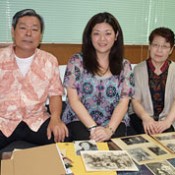
June 17, 2012 Ryukyu Shimpo
On June 13, 41 year-old high school teacher from Hawaii, Brenda Nomura, visited Okinawa on the high school student exchange program “Okinawa Prefectural Government Junior Study Tour,” which is run by the Hawaii United Okinawa Association and the Okinawa Prefectural Board of Education. While in Okinawa, she met Yasunori and Fujiko Matsuda, relatives on the mother’s side of her family living in Owan, Yomitan. Thrilled to meet them for the first time, Nomura said, “I have Okinawan blood. I am really moved that I have been able to find my relatives like this, and want to treasure my heritage.”
Nomura’s great-grandparents, Kensai and Kama Matsuda, were from Owan in Yomitan. In 1906, Kensai emigrated to Hawaii, before returning to Okinawa and moving again with Kama eight years later in 1914.
Nomura’s father was a father, who was a descendant of Japanese immigrants from Yamaguchi and Hiroshima and her mother was also a descendant of Okinawan immigrants. Nomura was very keen to meet her relatives in Okinawa. Tom Yamamoto, who visited Okinawa with Nomura, asked his friend living in Yomitan, Masaji Matsuda, to help, and this led to finding Yasunori and Fujiko Matsuda. Pictures of Kensai taken when he returned Okinawa in 1950s, and their store name, Miya-Machida, proved decisive in the search.
Their first meeting was at Yomitan High School, where the students from Hawaii had an exchange program.
Through finding her relatives, Nomura was impressed by the strength of the network of Okinawans.
Yasunori Matsuda said, “We haven’t had any contact with our relatives in Hawaii, so I am very happy to able to meet her.”
(English translation by T&CT, Megumi Chibana and Mark Ealey)
Go to Japanese

June 19, 2012 Ryukyu Shimpo
On June 15, at Kin Municipal Kagei Elementary School, which used to be the Yaka Prison Camp, where Japanese prisoners of war were accommodated during the Battle of Okinawa, the Yakabushi song written by the POWs was performed at a gathering held for peace education. Sayaka Kina of the Okinawa Prefectural University of Arts, who majors in Ryukyuan Performing Arts, and Yukio Seragaki, also of that university, sang the song, reminding the pupils of the plight of people at that time.
Before the performance a teacher explained the meaning of the lyrics, saying that they tell of how people held hopes for the future despite lamenting the fact that the land and people’s minds had been so badly affected by the war.
Kina wore monpe, or wartime women’s pants, and played a kankara sanshin, an Okinawan musical instrument that was often made from empty tin cans after the war. The pupils listened attentively to the performance.
At the gathering, pupils’ representative Yuki Yamashiro read a poem that he had written himself calling for peace. He said, “War can foster hatred between nations and feelings of discrimination that can rob people of their happiness, and damage their souls and their physical well-being. There will be no wars if people avoid localized conflicts, stop discriminating against others, and if people all over the world try to look after each other.”
Each month, the school holds a morning meeting entitled Home Song in which the pupils have an opportunity to consider various topics by listening to Okinawan songs. Last year, Kina’s teacher Masaharu Iha, who runs a sanshin school in Kin, also appeared at the gathering. However, Kina and Seragaki stepped in this time because Iha happened to be in France with an exchange project.
(English translation by T&CT, Mark Ealey)
Go to Japanese
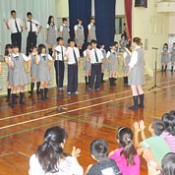
June 19, 2012 Ryukyu Shimpo
On Ikemajima, which is located to the north of Miyakojima in Okinawa Prefecture, local people are expanding the scope of their homestay business so they can accept students on school trips into the houses of fishermen and farmers. According to the Miyakojima Tourist Association, the homestay business of the island began in fiscal 2011, with about 250 inbound guests. The association expects approximately 5000 guests in fiscal 2012, and 7000 in 2013. When the initiative started on Ikemajima on June 11, 2011, only 20 host families were registered, so they could only accept school groups of approximately 100 students. However, after the association held workshops to promote the homestay business 57 new host families came forward, making it possible to accept school groups up to about 300 students.
In addition to on Ikemajima, the Miyakajima Tourist Association is promoting the homestay business at Hirara-Karimata, Miyakojima and on Irabujima. The association is responsible for sales to schools, and local groups on the islands liaise with the host families. On June 18, 317 second-grade students of the Okayama Joto High School, from Okayama Prefecture, visited Ikemajima as the first large-scale homestay tour to the island. On June 18 and 19, a total of 237 students stayed on Ikemajima and another 80 students at Karimata.
On June 19, the students had a farming and fisheries experience, after which they were immersed in the local cultural traditions with their host families. Each host family receives 5000 yen per person per night. The Tourist Association estimates that including the transportation expenses, the total economic benefit of the homestay tour of Okayama Joto High School will be about 6 million yen.
Kiyoshige Maedomari, whose family hosted students said, “This project will help bring life to the island, so we want to continue the homestay business. The children on the island will also learn many things through exchange with the students from the main islands of Japan.”
On June 18, at Ikema Elementary and Junior High School a welcome party for students from the Okayama Joto High School was held at which the children from Okayama gave a musical and choral performance
(English translation by T&CT, Mark Ealey)
Go to Japanese
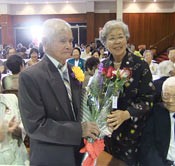
June 18, 2012 Mitsuhiro Akamine, correspondent of Ryukyu Shimpo
In the afternoon of June 2, at the Junji Nishime Kenjin-Kai Hall in Lima, Peru, the Association for Okinawan Women of Peru held its annual respect-for-the-aged ceremony, to which it invited almost 600 elderly people over 75 years of age. At the ceremony, from the Japanese Embassy there was the Consul Shigeru Iida and his wife, acting chairperson of the Japanese Association of Peru (JAP) Munetaka Ganaha, chairperson of the Japanese Women’s Association of Peru, Olga Oka, chairman of the Peru Okinawa Kenjin-Kai, Luis Takahara, and representatives of each of the municipalities of Peru.
The ceremony began with an opening address by the secretary general, Ruth Ige. After the singing of the song of the Association for Okinawan Women of Peru, the chairperson of the association Elena Ishimatsu greeted everyone, saying that the Japanese community that was established the hard way by the guests invited to the ceremony has passed on an approach that respects the elderly. The guests applauded and a stir rippled through the hall when Ishimatsu said in Uchinaguchi, “Ichimaden do ganjusashi nagaichi shimisori (I extend to you best wishes for a long and healthy life).”
After that, the chairman of the Kenjin-Kai, Luis Takahara, the chairperson of the JWAP Olga Oka, and the chairman of the JAP, Munetaka Ganaha, also gave speeches celebrating the guests’ longevity.
At the gathering, 104 year-old Zenson Nakahodo from Uruma, 103 year-old Choki Zukeran from Nanjo, 101 year-old Tsuyo Toyama from Okinawa City, 100 year-old Zenko Tamaki from Motobu, and other centegenerians received gifts and bouquets from Elena Ishimatsu.
On behalf of the elderly guests, Yoshikazu Oyakawa, an adviser to the Kenjin-Kai, thanked the Association for Okinawan Women for organizing the function and Consul Shigeru Iida proposed a toast to bring the ceremony to a close. The participants enjoyed the food that the Association for Okinawan Women had prepared, and the performances such as Ryukyuan dance, songs, sanshin, and karaoke.
(English translation by T&CT, Lima Tokumori and Mark Ealey)
Go to Japanese

June 14, 2012 Ryukyu Shimpo
On May 13, the Ministry of Defense submitted a report put together by the U.S. Marine Corps entitled, “Final Environmental Review for Basing the MV-22 aircraft at Marine Corps Air Station (MCAS) Futenma and Operating in Japan,” to the Okinawa Prefectural Government, Ginowan Municipal Office and Urasoe Municipal Office. In the review, the U.S. Marine Corps concluded that basing the MV-22 at MCAS Futenma and operating it from there would not result in any significant harm to the environment.
However, data indicates that the environmental burden on Okinawa will increase due to the number of annual operations planned for the MV-22 Osprey vertical take-off and landing transport aircraft at the Ie Shima Training Facility (ISTF). The Marine Corps will increase the number of operations for the Osprey aircraft to more than 2.3 times that of the CH-46 transport helicopter. Training for the Osprey may be held as many as 6760 times a year, compared to the 2880 times for the CH-46 during 2010. The MV-22 has recorded a mishap rate of 1.12 per 100000 flying hours, which is lower than the 2.47 for the average for all aircraft of the U.S. Marine Corps, but this data does not include the crash that occurred in April this year in Morocco. The review specifically states that the U.S. Marine Corps will operate the Osprey in the Central Training Area (CTA), the Northern Training Area (NTA), Camp Hansen, Camp Schwab, and from Kadena Air Base, implying that they will operate the aircraft throughout Okinawa.

U.S. military bases and training areas in Okinawa where the Marine Corps will operate the MV-22 aircraft. (Click to enlarge)
The Marine Corps has suggested that increased use of sophisticated simulators will reduce the overall operations for the MV-22 at Futenma Air Station by 11% annually. However, the number of operations will increase to 280 times per day, which is 3.7 times the frequency of the CH-46 operations, which averaged 76 times per day, both during the night and early morning (10:00pm-7:00am next day).
At the ISTF, the MV-22 squadrons will carry out Field Carrier Landing Practice (FCLP), simulating an aircraft carrier “deck” at the ISTF complex, as is currently carried out by the CH-46 squadrons. The MV-22 squadrons will carry out about 2500 FCLP, which represents 37% of all FCLP annual operations over Iejima. In addition, the squadrons will implement a Terrain Flight (TERF) route along which the CH-46 currently flies at low-altitudes (50 to 200 feet above ground level) at the NTA. The Marine Corps suggests that Confined Area Landings (CAL) training at the existing landing zones would decrease overall by about 12% from current levels, with a decrease in the use of landing zones in the NTA and CTA and an increase in operations for the ISTF complex. The squadron will operate at the newly constructed landing zone within the NTA near Takae, in the Higashi area. The MV-22 squadrons will fly over Kadena Air Base 1200 times annually in order to carry out ammunition supply.
With regard to the environmental impact of the MV-22 squadrons, the Marine Corps has pointed out that in the NTA there would potentially be impact on the karasu-bato, or Japanese wood pigeon, and the Yambaru-kuina, or Okinawa Rail, which is a protected species. The Marine Corps said that from 2003 through 2011, the MV-22 recorded a mishap rate of 1.12 per 100000 flying hours, which was lower than the Corps average, but this did not include the crash in Morocco. The mishap rate for the aircraft submitted by the Ministry of Defense was 1.93, which included the crash in Morocco.
In the review, with regard to low-frequency noise from the operation of the aircraft, the Marine Corps quoted data from the alternative facility construction plan for the relocation of Futenma Air Station to Henoko, Nago, without carrying out any research by itself. The matter of low-frequency noise emitted by the aircraft is a controversial issue in Okinawa.
In the review, the Marine Corps has not provided data covering the Henoko in Nago, the location where the alternative base for Futenma Air Station is due to be constructed.
MV-22 squadrons will fly to and from Camp Fuji in Shizuoka Prefecture and Iwakuni Air Station in Yamaguchi Prefecture.
(English translation by T&CT, Mark Ealey)
Go to Japanese

June 17, 2012 Ryukyu Shimpo
On June 14 at the Kitanakagusuku Village Central Community Center, the College of Social Work of Oba School delivered a lecture on the Battle of Okinawa. Toshie Asato, co-leader of the Okinawa Umanchu Association, Okinawa branch of the Article 9 Association, who delivered the lecture, emphasized how precious peace is as she talked about her own experiences of war.
Asato, who wandered around the battlefield with her family, said, “I saw civilians fleeing in miserable circumstances, but I could do nothing to help them, and so I shut what I was seeing out of my mind. This is what war is like.” Asato talked about how the abject cruelty of war sees the spirit of helping others disappear.
Losing most of her family members, including her two children, Asato said, “I lost everything in the war. We should never repeat war and such killing again.” She went on to say, “We have to be cautious about what direction our society is headed.”
Hatsuko Nakamura, who is engaged in dramatic reading activities, read a picture book entitled Norihide, which is based on Asato’s experiences.
The school annually delivers a lecture for peace education, aiming to make students think about the importance of welfare by learning about “war,” which is at the other extreme of the scale of activities that impact upon people’s happiness.
(English translation by T&CT, Mark Ealey)
Go to Japanese

June 18, 2012 Ryukyu Shimpo
On June 12 at Nago Municipal Kube Elementary School, 79 year-old Keiko Taira spoke to a group of elementary school pupils about her experience as a survivor from the Tsushima-Maru, an unmarked Japanese passenger-cargo ship carrying hundreds of evacuated school children that was sunk in 1944 by the submarine USS Bowfin.
Taira said to the pupils, “Localized conflicts could still occur if people do not care enough about others. During your time at school, I want you to look after each other.”
On August 22, 1944, the Tsushima-Maru was sunk by the USS Bowfin while on its way from Okinawa to Kagoshima.
A total of 1422 passengers, including 777 school children died.
Taira was fourth grader at a national elementary school at that time. She, her grandmother and elder sister, brother and cousins were on board the ship. Taira told the children how she was hurled out into the sea when the ship listed to one side. During her time drifting at sea for six days she saw people dying one after another. Taira managed to survive because she remembered how her mother had said that they would definitely meet again that next March.
She said, “I was happy before the war because I never imagined that fighting would break out. After it ended, I could not forget the many people who died. I worry about a war occurring again and how long peace will continue. So, that’s why I’ve come to tell you about my experiences.”
Mirai Shimabukuro, a sixth grader at the school said, “I understand that peace means not only that we don’t have wars, but that we live happily.” Another pupil, Takumi Toyoshima said, “I think that the fact that we are all here today is what peace is all about.”
(English translation by T&CT, Mark Ealey)
Go to Japanese

June 17, 2012 Ryukyu Shimpo
From 2:00pm on June 17 at the Ginowan Outdoor Theater, a rally was held to protest against the deployment of the MV-22 Osprey vertical take-off and landing transport aircraft to the U.S. Marine Corps Air Station Futenma, and against the base becoming a permanent fixture at Futenma. The participants in the rally demanded the early closure of the base and the return of the land that it uses. According to a representative of the rally executive committee, about 5200 people gathered including residents who live close to the base constantly in fear of a crash by a military aircraft and annoyed by the noise generated, as well as people who live in the municipalities that host U.S. military bases. Because of the significant risk of its crashing, they demanded that the Japanese and U.S.
governments cancel the plan to deploy the Osprey aircraft to Futenma Air Station.
The protesters also demanded that the Japanese and U.S. governments return the land used by the base as soon as possible and ease the excessive burden placed on Okinawa by hosting U.S. military bases for the 67 years since the end of the war. The protest rally adopted resolutions against the deployment of the Osprey to the base, and demanding the early closure of the base and the return of the land used by it, and also demanded that the Japanese and U.S. governments clarify the schedule of the closure and return of the base.
Osprey aircraft have been crashing with disturbing regularity during its developmental stages. This April, an MV-22 Osprey crashed in Morocco, killing two U.S. Marines, and on June 13, a U.S. Air Force CV-22 Osprey crashed in southern Florida during training, injuring five crew members on board. With the safety issues still unresolved, the U.S. military plans to deploy 12 Osprey aircraft to Futenma Air Station in August and the Japanese government has accepted this timing.
Ginowan Mayor Atsushi Sakima, the head of the rally executive committee, gave a speech, and representatives of high schools and the university in Ginowan, Emiko Taira, the head of the Ginowan Municipal Women’s Federation, Shinryu Tawada, the head of the Ginowan Municipal Federation of Senior Citizen’s Club, Kinue Nakamura, the head of the Ginowan Municipal Federation of PTAs, and Choko Futenma, the head of the Ginowan Municipal Youth Development Council all voiced their opinion. Okinawa Governor Hirokazu Nakaima delivered a message at the rally.
On June 19, Nakaima and Sakima demanded that the Japanese government cancel the deployment plan. On July 5 and 6, representatives of the executive committee will go to Tokyo to appeal to Prime Minister Yoshihiko Noda, Foreign Minister Koichiro Genba and newly appointed Defense Minister Satoshi Morimoto.
Referring to accidents involving the Osprey in April and June, Sakima clearly said, “Those accidents once again prove the dangerous nature of the Osprey. We would like the Japanese and U.S. governments to immediately cancel the deployment plan.” With regard to Futenma Air Station, Sakima said, “We want to take all necessary measures to see the land used by the base returned as soon as possible.” Nakaima said, “I oppose the deployment plan because not enough information has been provided to verify its safety.
Takemasa Kyan, a representative of high schools said, “It is too late once an accident has happened. I do not want the Osprey to be deployed to Ginowan.”
Although more than 16 years have passed since April 1996 when the Japanese and U.S. governments agreed to return Futenma Air Station to Okinawa, this has not yet come about.
(English translation by T&CT, Mark Ealey)
Go to Japanese
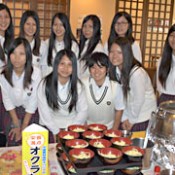
June 13, 2012 Ryukyu Shimpo
Management of the Castle Highlander, a general-purpose wedding hall in Tengan, Uruma, have decided to offer on their lunch menu once a month okra noodles that Chubu Agricultural High School students have created using imperfect okra. Okra is a local product, and the students are enthusiastic about this initiative that combines learning and assists the local economy.
These okra noodles are made by processing imperfect okra high in fiber into paste before kneading it into flour. The students started to develop the product last November and introduced it at a festival held in Haebaru, Uruma, a production base of okra.
Yoshiaki Toyama, who is the master chef at the Castle Highlander and teaches a cooking class at the school, pushed for the adoption of the noodles on the lunch menu. Toyama said that the okra noodle has a good smell, color and springy texture.
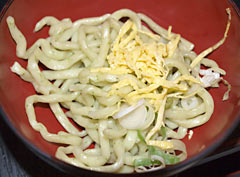
Okra noodles made using sub-standard product is characterized by its stringy texture.
The noodles will be offered on the lunch menu on the second Friday of each month. Sakino Kamiya, a student making the noodle, said, “It is difficult to get the amount of water right to make the noodles. We had problems utilizing the features of okra.” Riko Koura said, “I’m very happy that the noodles we have made will be supplied as a product like this.”
Jin Yakabi, a teacher who teaches the food science courses at the school, said, “It really was trial and error during the development stage. Eating these noodles will help to promote Uruma for the production of okra, and I hope that this okra noodle helps farmers, and boosts the local economy.”
(English translation by T&CT, Lima Tokumori and Mark Ealey)
Go to Japanese
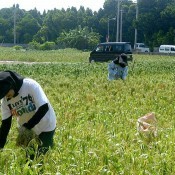
June 12, 2012 Toshihisa Higa, correspondent of Ryukyu Shimpo
On Tonaki Island, glutinous millet which had seeds sown during Usui, the second term in the East Asian lunisolar calendar, is now ready for harvest, so local farmers are busy harvesting the crops during sunny spells in the rainy season.
According to the Tonaki Village Economic Affairs Division, there were no crops harvested last year because of damage from typhoons, but the farmers were able to plant ten hectares of the land. They expect them to grow well with the good weather. The rice-polishing machine has been replaced with a new model in order to supply high-quality glutinous millet.
The harvest of glutinous millet is laborious work carried out with a hook to pick them one by one. With neighbors helping out, the harvest will continue until the middle of June. Threshed glutinous millet can be seen drying in the sun on the farmers’ land.
(English translation by T&CT, Lima Tokumori and Mark Ealey)
Go to Japanese













 Webcam(Kokusai Street)
Webcam(Kokusai Street)


